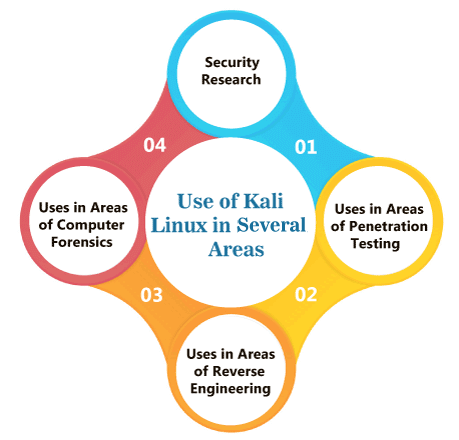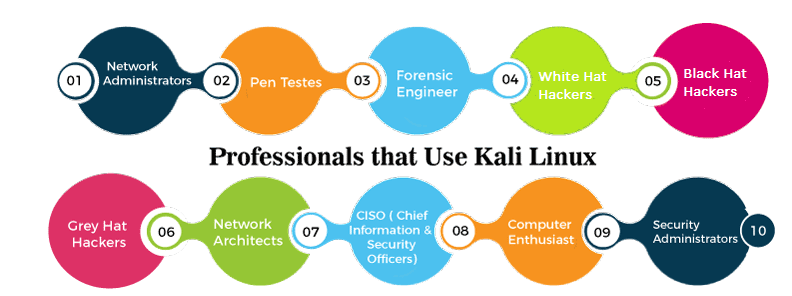Use of Kali LinuxKali Linux is a Debian-based Linux distribution specifically designed for penetration testing and security auditing, as it comes with over a hundred tools for this purpose. Debian-based distribution is an open-source Linux distribution supported by a Debian Project community, first started in 1993 by Ian Murdock. Although the Kali Linux distribution was first introduced in 2013, it is still in use today. It was previously known as Backtrack in Linux before being renamed Kali. In this tutorial, we will discuss the various use cases for Kali, as well as the utilities that this distribution provides when it is used in those areas of utility! Use of Kali Linux in Several AreasBefore we get into the different use cases or use areas of Kali Linux distributions in today's world, let's have a look at its history so that the use cases will be considerably more promising in what tasks they do. Prior to the development of Kali Linux, the first project started was Whoppix, which stands for WhiteHat Knoppix. To be clear here, Knoppix is the underlying operating system in this Linux distribution, and Whitehat is used in the internet as slang for people who hack computers, but in a moral sense. That's where everything started about using this distribution for anything related to ethical hacking. Now ethical hacking comprises other layers of division such as penetration testing, researching on the security of information system of an organization etc. Post Whoppix, it made way for transforming itself to WHAX, where the underlying operating system changed from Knoppix to Slax. Simultaneously, the Auditor Security Collection operating system was being developed, and the efforts of WHAX and Auditor were integrated to build BackTrack. With the knowledge gained from various versions of BackTrack, it was decided to give a new face for this distribution under Debian based license terms and conditions. Kali has since debuted and lived under the hood of Debian based distribution, eventually became one rolling operating system. With the history, this distribution offers hundreds of tools developed for information security tasks, including penetration testing, security research computer forensics, and reverse engineering. Let's discuss use of Kali Linux in several areas: 
1. Security ResearchBy investing yourself in researching on the IT security genre and continuing to evolve the tools on the same, one can easily enhance the security a step higher using the tools available for penetration testing. This aspect of Kali Linux's ties closely with penetration testing. 2. Uses in Areas of Penetration TestingIf we are talking about penetration testing, Kali Linux is an undisputed choice of all testers. The tools included in Kali Linux come from a variety of security and forensics niches. The tools included in the Kali Linux distribution are divided into many categories, which are not comprehensive but cover the most commonly used ones, and they are:
Not only tools, but Kali Linux also offers users with meta-packages, that allow them to install a subset of tools tailored to their individual needs. Last but not least, Kali Linux is a rolling operating system distribution; therefore, there is a standard version control followed, and the version tracking website allows users to compare the current upstream version with the one that is now in Kali. 3. Uses in Areas of Reverse EngineeringWhen we were younger, we used to play with puzzles, tearing apart the problem that came in a box and then putting the parts back together to study and develop the human intellect. Reverse engineering is the same for security professionals who use Kali Linux. We can identify the source of the attack using forensics, and using reverse engineering by security professionals, and we will be able to spot flaws by identifying their technology and build a more robust system so that in the near future, such attacks can be avoided! In the Kali Linux distribution, we can use the following tools to accomplish reverse engineering:
Using these tools, security professionals see reverse engineering as a critical tool for maintaining competition and developing protection systems against future threats! 4. Uses in Areas of Computer ForensicsIn today's society, any organization, or even a person, is vulnerable to external attacks and security breaches. Cyber attackers frequently carry out these acts. Once an attack has been carried out, computer forensics is used to determine the root cause of the attack and the appropriate course of action to respond to it. This is where the Kali Linux distribution comes in, and the tools for penetration testing, as well as the 14 unique tools for computer forensics, making it the most extensively used operating system for computer forensics. Some of the tools that are important in this are:
Many of the tools mentioned above appear to have some connection to medical science's forensics area. Another feature of the Kali Linux distribution is that when the forensic mode is enabled in the boot menu, the tools prevent any activity that could cause a change in the data analysis. Who Uses Kali Linux and Why?Kali Linux is a one-of-a-kind operating system that is freely utilized by both good and bad individuals. This operating system is heavily used by Security Administrators and Black Hat Hackers. One is responsible for detecting and preventing security breaches, while the other is responsible for identifying and perhaps exploiting security breaches. Professionals that Use Kali Linux
1. Network AdministratorsNetwork administrators are in charge of keeping the network running smoothly and securely. They audit their network with Kali Linux. For example, Kali Linux provides the capacity to detect illegitimate access points. 2. Pen TestersPen testers use Kali Linux to audit environments and perform reconnaissance on the corporate environments they've been recruited to examine. 3. Forensic EngineersIn some cases, a Forensic Engineer can use Kali Linux's "Forensic Mode" to perform data discovery and recovery. 4. White Hat HackersWhite Hat Hackers, like Pen Testers, utilize Kali Linux to audit and discover potential vulnerabilities in a system. 5. Black Hat HackersBlack Hat Hackers use Kali Linux to find and exploit vulnerabilities. Kali Linux also has a number of social engineering applications that a Black Hat Hacker can use to cooperate with an organization or an individual. 6. Grey Hat HackersGrey Hat Hackers are in the middle of the White Hat and Black Hat Hackers. They'll use Kali Linux in the same way as White Hat Hackers and Black Hat Hackers. 7. Network ArchitectsNetwork Architects are responsible for designing secure networks environments. They use Kali Linux to audit their initial designs and make sure nothing was missed or misconfigured. 8. CISO (Chief Information Security Officers)CISO use Kali Linux to internally audit their environment and see if any new apps or rouge configuration have been installed. 9. Computer EnthusiastAlthough "computer enthusiast" is a broad word, anyone attentive in learning more about networking or computers, in general, can use Kali Linux to gain a better understanding of IT, networking, and common vulnerabilities. 10. Security AdministratorsSecurity administrators are responsible for protecting their organization's information and data. They use Kali Linux to review their environment and make sure there are no easily exploitable flaws.
Next TopicHow to install VPNbook on Kali Linux
|
 For Videos Join Our Youtube Channel: Join Now
For Videos Join Our Youtube Channel: Join Now
Feedback
- Send your Feedback to [email protected]
Help Others, Please Share










